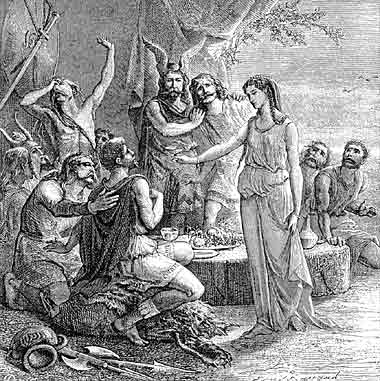- Home
- Gauls and Greeks
- The Gallic populations of Provence
- Gallic populations according to ancient sources
An image of conflicting relations
Ancient texts have provided limited information concerning the indigenous societies surrounding Greek Marseilles towards the end of the second Iron Age. In addition to the common descriptions of the “barbaric” customs of these Celtic and Ligurian populations, a leitmotif has emerged from Late-Hellenistic writings and more recent compilations: that describing the great danger and military pressure imposed by this indigenous community on the Phocaean colony, its territories and commercial interests. Indeed, the very day after the mythic idyll of Gyptis, daughter of Nanos, king of the Segobriges, and the Phocaean, Protis, conflicts with the indigenous inhabitants multiplied. While this community was indispensable to the economy and trade of Marseilles, it was not a reliable ally.
Ancient texts and recurring archaeological evidence (burned villages, for example) give us a glimpse of these violent rivalries from the 6th to 2nd centuries BC. In the 1st century BC, the Gallic historian Trogue-Pompée harshly criticized these "Ligurians jealous of the progress of our city […] and who harass the Greeks with continual wars" (ap. Justin, XLIII, 3).
The legend of the foundation of Marseilles: Gyptis, the daughter of the king of Segobriges, chose her spouse during a feast. She deserted the Gauls and chose Protis, who had recently arrived from Greece. The king offered him a location in which to found a city, Massalia. Engraving from the 19th century, from L’Histoire populaire de la France, around 1875.
On the coast, attacks by Ligurian pirates forced the Greek city to reinforce protection of its maritime commercial routes during the 4th, 3rd, and early 2nd centuries BC through the creation of defensive colonies. Archaeological evidence shows traces of terrestrial military interventions around Berre Pond as early as 200 BC.
This feeling of insecurity was inspired by "the Salluvian Gaules who pillage our territory" (Tite-Live, Epit. 60) and who "perform armed robbery on earth and sea…" (Strabon, Géographie, IV, 6, 3). It drove the Phocaean city to fortify itself, to be wary of strangers, and to arm itself with a powerful arsenal. The permanent danger was poignantly emphasized by the Latin historian and poet Silius Italicus, who depicted the inhabitants of Marseilles at the end of the 3rd century BC as a people "surrounded by arrogant tribes and terrified by the savage rituals of their barbaric neighbors" (Punica, XV 169-172).
Affirmation of an aristocratic class
In the Midi (southern France), and elsewhere in Gaul, the 3rd and 2nd centuries BC were characterized by the rapid development of various economic forms and the political affirmation of an aristocratic class. Western Provence, which was long maintained under the commercial domination of Marseilles, experienced a difficult transformation riddled with tensions and profound cultural divergences, unlike other Mediterranean regions. These difficulties resulted in a succession of confrontations in the hinterland of the Greek city and along the coast.
The agglomeration of Entremont, near Aix-en-Provence, is located in the heart of the Saylen territory. Ancient historians associate it with ancient testimonies to the overtaking of the "last citadel" of the federation. The artifacts recovered provided a very explicit image of the transformations that took place during this time in the economic and social lives of these populations. In addition, the exceptional sculptures discovered there provide us with a precious gallery of portraits of the aristocratic families who exercised their authority and prerogatives over the surrounding territories as early as the 3rd century BC.

